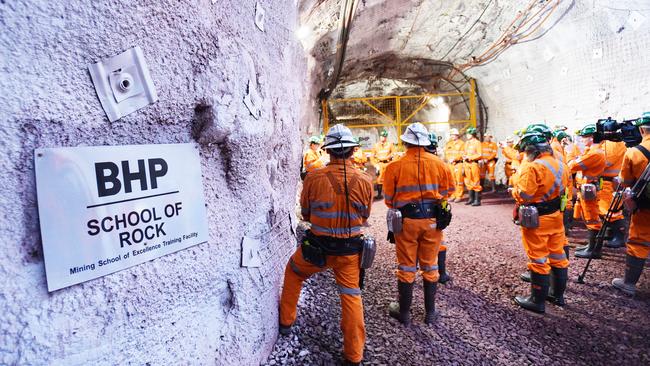BHP iron ore shipments soften in March quarter, but Olympic Dam output hits five-year highs
BHP’s Olympic Dam mine hits highest quarterly production rate in five years, while iron ore shipments soften amid record prices.

BHP is within sight of record output from its dominant Pilbara iron ore division as the price of the steelmaking commodity nudges record highs and cash pours into the company’s coffers.
The iron ore price hit $US189.61 a tonne on Tuesday, the highest levels since 2011, close to record levels in Australian dollar terms, leaving BHP poised to deliver a bumper cash return to shareholders on the back of a strong operational performance and high commodity prices.
BHP iron ore shipments softened in the March quarter, with the company exporting 66 million tonnes of the steelmaking material, slightly below analyst expectations.
The company shipped 68.5 million tonnes in the March period in 2020, and 70.8 million tonnes in the three months to the end of December.
But the result still leaves the company easily within reach of an annual export record and, with guidance intact for a cash cost of production at $US13-$US14 a tonne despite rising costs in the Pilbara, it is probably making margins of better than $US140 a tonne at current prices.
BHP exported 283.3 million tonnes of iron ore last financial year, and needs to ship only 73.1 million tonnes in the June quarter — traditionally the Pilbara’s strongest period — to beat that mark this year.
BHP gives its guidance in production terms, not tonnes shipped, but needs to ship only 76 million tonnes in the period to beat the 286 million-tonne top end of its annual output range.
This time last year BHP’s Pilbara logistics chain was running at a rate of 300 million tonnes a year for the June quarter, exporting more than 77 million tonnes for the period.
Despite being within reach of fresh records as it enters its annual sprint to the end of the financial year, BHP took a cautious approach to its expectations for the year, saying only that it expected output to sit in the top half of its previous guidance range of 276-286 million tonnes.
But even current guidance leaves BHP poised to deliver a return to shareholders that could top $US8.8bn ($11.4bn), according to Morgan Stanley analysts, who on Wednesday tipped a final dividend of $US1.75 a share from the mining major.
Its capacity to push output in the June quarter may be constrained by the ramp-up of its new South Flank mine, where commissioning work begins this quarter, with the company saying the need to tie in infrastructure at the project to its port and rail network — along with planned maintenance work and heavy weather in the Pilbara cyclone season — was to blame for the March quarter slowdown in output.
BHP’s Pilbara operations produced 66.7 million tonnes of ore during the period, and the company said it expected its new South Flank mine to begin commissioning in the current quarter, with first production on schedule for the middle of the year.
BHP also delivered some good news from its Australian copper operations on Wednesday, as copper prices rose this week to lift briefly above $US9400 a tonne, suggesting its turnaround plan for Olympic Dam is working, as quarterly output from the mine hit the highest levels in five years, at 55,400 tonnes of copper.
Its output of 155,000 tonnes in the nine months to the end of March is now up 25 per cent on the previous corresponding period, with BHP flagging annual output towards the top end of its range of 180,000-205,000 tonnes.
Total copper production across BHP’s global assets fell 8 per cent compared to the March period in 2020 to 391,400 tonnes as output from its Escondida and Pampa Norte operations fell.
Falling grades at Escondida, and the impact of labour shortages due to the coronavirus, hit the massive mine’s output in the period, and Pampa Norte’s production fell 21 per cent due to labour shortages and planned maintenance.
But good performances across its iron ore and copper operations could be undermined by falling output in its coal division, with BHP saying this year’s wild weather in Queensland and NSW hit its metallurgical and thermal coal production.
Its Queensland mines produced 9.6 million tonnes of coking coal in the period, up 1 per cent on the December quarter, but BHP cut its annual output guidance to 70-73 million tonnes, from 71-77 million tonnes.
BHP also cut thermal coal expectations, saying it now expected its Mount Arthur and Cerrejon mines to produce a total of 14-15 million tonnes for the year, down from 15-17 million tonnes.
BHP shares fell 41c, or 0.5 per cent, on Wednesday to $47.04.



To join the conversation, please log in. Don't have an account? Register
Join the conversation, you are commenting as Logout